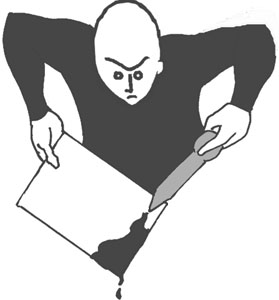![[Metroactive Features]](http://metroactive.com/features/gifs/feat468.gif)
[ Features Index | Silicon Valley | Metroactive Home | Archives ]
I Was Wrong
By Annalee Newitz
SOMETHING WEIRD happened while I was running a gel in one of the student biology labs at MIT's famed Whitehead Institute. I realized that I had changed my mind about the nature part of the nature vs. nurture debate. Or rather, I had changed my mind about the debate itself--I'm starting to believe that that "vs." should be an "and." It's a haunting, double-consciousness sort of feeling when you suddenly change a deeply held opinion. You start paging back through your entire life, all your philosophical decisions, looking for errors. I suppose it's like debugging your brain.
For years, I've argued that humans are entirely a product of their cultural environment, and I still believe that. But as I stood in that lab, surrounded by microscopes, long cabinets packed with tinfoil-capped flasks and rubber buckets of DNA samples packed in ice, I stared at a pipette full of genetic material and thought, That's all there is. Once you get down to the micro levels, the places where ribosomes pound out chains of amino acids and polymerase unzips your DNA, you are confronted with the undeniable fact that your body is running a program over which you have minimal control.
I was part of a group of visitors about to be instructed in the ways of PCR (polymerase chain reaction) and electrified gels. My hands were sweating inside the tight latex gloves the grad students told us to wear all the time. "You're working with powerful mutagens that stick to your DNA," one of them said with a wry smile. "So keep the gloves on."
Using the same techniques that investigators use in crime labs, I was about to identify someone based on DNA. Well, I use the term "someone" a bit loosely. A group of friendly biology grads had arranged for us to conduct a fake "investigation" in which we would attempt to identify a mouse based on a tiny sample of its DNA. What I was unprepared for was how damn messy and inexact the whole process seemed. We mixed the DNA using pipettes, which are no more than highly precise turkey basters. To sequence the stuff, we popped our samples into a PCR machine, an extremely nonimposing piece of equipment that looks like nothing so much as an electric bread maker--and, indeed, its role is to heat and cool DNA samples so that they will "amplify," or replicate. Once you have about a zillion pieces of the DNA you want to sequence, you finally get to squirt the DNA into a specially prepared gel.
And it was at that moment--when I was squirting a few microliters of bodily fluid into a slightly squishy gelatin--that I changed my mind about biology. How could I, a devotee of cultural analysis, not embrace such a ridiculously untidy discipline? With all its mutable complexity and overdetermined causality, biology is just as goofy as culture. A biological event like, say, cancer, could be caused by thousands of different things, all happening in a random order over a period of decades. Likewise, a cultural event like feminism or war is so complex that it can hardly be reduced to a single, linear sequence of events. Like the DNA in the gel, culture is messy. And analyzing it requires us to hold many possibilities in our minds at once. In biology and in culture, there are many processes, many outcomes and many origins. No two biological events are exactly alike.
So what was this whole "running a gel" thing all about? I had heard my biologist friends talk about it so much that I viewed the process of DNA identification as some kind of ridiculously sanitized, exact high-tech process. But it was, quite literally, about making hapless chunks of DNA run across a gel. We poured our gels into plastic trays fitted with electrodes. Once the gel hardened, we immersed it in a saline solution, did our DNA squirting and shot electrical current through the whole mess. Because DNA has a mild negative charge, it migrated away from the negative electrode. Smaller bits of the amplified DNA moved quickly, while bigger ones moved slowly.
When the DNA finished "running" across the gel, it left behind a characteristic "bar code" pattern whose shape could be compared with other DNA patterns to identify our evil mouse perpetrator. How did we see all these bar code patterns? With a Polaroid camera, of course. Using this singularly pedestrian piece of equipment, we picked up the UV radiation in the dye we'd mixed with our DNA samples and were able to see the unique set of lines created by our particular mouse's DNA.
I tapped my latex-gloved fingers against the edge of a microscope and wondered what would happen if I stole a flask. They looked so damn cool, like geeky candy jars. What had aroused this thought? Was it my upbringing, surrounded as I had been by hackers, subversive writers and sarcastic leftists? Or did it come from some kind of genetic predilection to be disobedient? As I regretfully left the flasks behind me in the lab, I realized that it didn't really matter if my urges were cultural or biological. My behavior would remain unchanged. And my attitude about that behavior would remain unchanged as well. Maybe ethics are biological, too. It's hard to say. These things are so messy.
[ Silicon Valley | Metroactive Home | Archives ]
Copyright © Metro Publishing Inc. Metroactive is affiliated with the Boulevards Network.
For more information about the San Jose/Silicon Valley area, visit sanjose.com.
![]()

Techsploits
Send a letter to the editor about this story to letters@metronews.com.
From the December 19-25, 2002 issue of Metro, Silicon Valley's Weekly Newspaper.